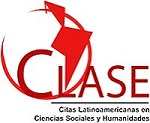Design of a computer program to calculate the ecological footprint of food
Keywords:
ecological footprint, food, municipal level, calculation softwareAbstract
Its presents the process of designing a computer program to calculate the Ecological Footprint of Food, whose proposes a tool useful, in special to meet the food consumption of a community and to plan actions for local food production. The steps to develop the program, which is supported by the Service-Oriented Architecture, are described. This first version includes labeling modules, surveys design, product parameterization, data loading, data verification, ecological footprint calculation and reporting. The program is applied in a city of medium scale of Northwest of the province of Chubut, in the Patagonia andina argentina. The results, although they are preliminary, realizes that the program can be a valuable contribution for the purposes previously mentioned.Article Metrics
Abstract: 557 PDF (Español (España)): 278References
ANDRADE, Chris, LIVERMORE, Shawn, MEYERS, Mike y VAN VLIET, Scott. (2007). Professional WPF Programming: NET development with Windows Presentation Foundation.1a . ed. New York: Editorial Wrox. Pp.429.
ARGENTINA. Instituto Nacional de Estadísticas y Censos.(2011). Provincia del Chubut. Población total y variación intercensal absoluta y relativa por departamento. Años 2001- 2010. Censo Nacional de Población, Hogares y Viviendas 2001 y 2010. Disponible en Internet: http://www.estadistica.chubut.gov.ar/archivos/Censo2010/poblacion/ P1-P_Chubut.xls. Consultado 11.06.14.
CARABELLI, Francisco, FORTI, Laura, BAROLI, Carlos y TABARES, Claudia. (2012). La Huella Ecológica como estrategia de intervención en ámbitos comunitarios. Una herramienta para promover la interacción entre saberes que fortalezca el desarrollo local. En: Libro de Trabajos en Extenso del 1er. Congreso Latinoamericano de Ecología Urbana. Desafíos y escenarios de desarrollo para las ciudades latinoamericanas. Universidad Nacional de General Sarmiento, Buenos Aires: Ed. Universidad Nacional de General Sarmiento. Pp. 415-426.
CARABELLI, Francisco, FORTI, Laura, HESSY, Laura, MENDOZA, Nora, BAROLI, Carlos y TABARES, Claudia. (2011). Promoviendo la transformación positiva de nuestro impacto sobre el entorno: La Huella Ecológica de la Villa Futalaufquen (Parque Nacional Los Alerces) y su potencial para generar nuevas formas de utilizar el capital natural. En: Actas del V Congreso Iberoamericano sobre Desarrollo y Ambiente, Red Iberoamericana de Economía Ecológica. Santa Fe. Disponible en Internet: http:// fich.unl.edu.ar/CISDAV/upload/Ponencias_y_Posters/Eje06/Carabelli_Forti_Hessy_ Mendoza_Baroli_Tabares/Trabajo%20completo%20Carabelli%20y%20col.%20 Eje%206.pdf Consultado 21.06.14.
CARABELLI, Francisco, DEMARCHI, Gabriela y BAROLI, Carlos. (2008). Desarrollo local de la Comarca de la Meseta Central de Chubut. En: ELGUE, Mario. (Comp). Emprendedores de la Economía Social. Buenos Aires: Ed. Ciccus.Pp. 109-140.
DI PIETRO, Luis José. (2001). Hacia un desarrollo integrador y equitativo: una introducción al desarrollo local. En: BURIN, David y HERAS, Ana Inés. (Comp.). Desarrollo Local. Una respuesta a escala humana a la globalización. Buenos Aires. Ed. Ciccus-La Crujía. Pp. 13-50.
JOHNSON, Bruce, MADZIAK, Peter y MORGAN, Sara.(2009). Microsoft .NET Framework 3.5 – Windows Communication Foundation. 1a . ed.Redmond:Editorial Microsoft Press U.S.593 Pp.
LOWY, Juval. (2007). Programming WCF Services.1a . ed. Sebastopol: Editorial O´Reilly Media.634 Pp.
MAX-NEEF, Manfred, ELIZALDE, Antonio y HOPENHAYN, Martín. (1994). Desarrollo a Escala Humana. Conceptos, aplicaciones y algunas reflexiones. Montevideo: Ed. Nordan-Comunidad, 148 Pp.
MICROSOFT CORPORATION. (2006). “Whitepaper: La arquitectura SOA de Microsoft® aplicada al mundo real”. Redmond: Microsoft Corp., 21 Pp.
PETKOVIC, Dusan. (2011). Microsoft SQL Server 2008: Manual de referencia.1a . ed. Ciudad de Mejico: Editorial McGraw Hill Interamericana,744 Pp.
REES, William. (1996). Revisiting carrying capacity: area-base indicators of sustainability. Population and Environment: A Journal of Interdisciplinary Studies, Vol. 17(3). Berlin: Ed. Springer,Pp.195-215.
RESNICK, Steve, CRANE, Richard y BOWEN, Chris. (2008). Essential Windows Communication Foundation For .NET Framework 3.5. 1a . ed. Boston: Editorial Pearson Education, 553 Pp.
RODRÍGUEZ, Flavio B. (2005). Nuestro pan de cada día. La Huella ecológica alimentaria de Bogotá. En: CÁRDENAS, Felipe, CORREA, Hernán Darío y MESA, Claudia (Comp.). Región, Ciudad y Áreas Protegidas. Manejo Ambiental y Participativo. 564 Pp. 1a ed. Bogotá. Ed. Fescol, Ecofondo, Acción Ambiental, Cerec.
SOLIS M., Daniel. (2009). Illustrated WPF.1a . ed. New York: Editorial Apress,495 Pp.
SUTCLIFFE, Marcus, HOOPER, Paul y HOWELL, Ros. (2008). Can Eco-Footprinting Analysis Be Used Successfully to Encourage More Sustainable Behaviour at the Household Level? Sust. Dev. Vol. 16. London. Ed. Wiley Interscience, Pp. 1-16.
WACKERNAGEL, Mathis, DHOLAKIA, Ritik, DEUMLING, Diana y RICHARDSON, Dick. (2000). Assess your Household´s Ecological Footprint. Redefining Progress, v. 2.0. Disponible en Internet: http://greatchange.org/ng-footprint-ef_household_ evaluation.xls. Consultado 11.01.15.
WACKERNAGEL, Mathis y REES, William. (1996). Our Ecological Footprint. Reducing Human Impact on the Earth. The New Catalyst, Bioregional Series 9, Gabriola Island, Canada: New Society Publishers, 160 Pp.





















